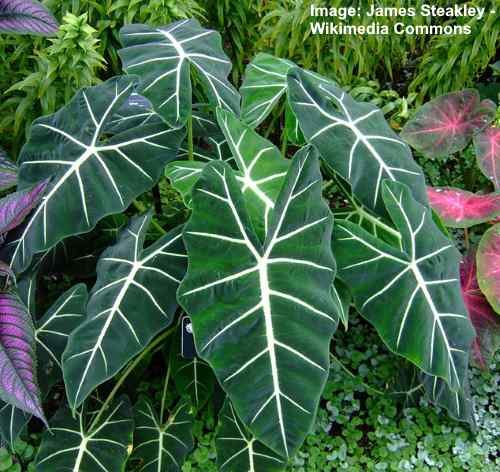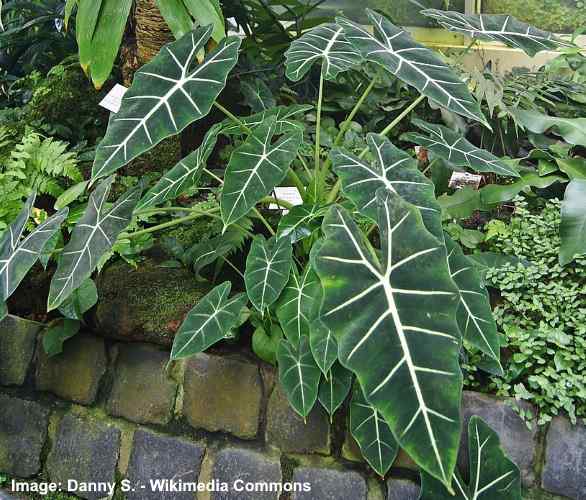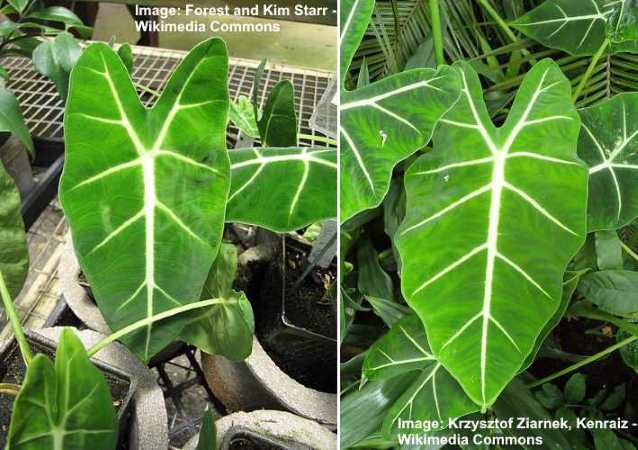Alocasia Frydek: Care and Growing Guide

Alocasia Frydek (Alocasia micholitziana ‘Frydek’) is a stunning tropical perennial houseplant with large arrow-shaped leaves with thick white veins. Also called the Green Velvet plant, the Alocasia Frydek grows well indoors if it gets enough light and humidity. Like all species of Alocasia, the Green Velvet alocasia produces unusual white, slightly fragrant flowers.
Alocasia micholitziana ‘Frydek’ is grown indoors for its spectacular foliage. The tropical indoors plant has compact growth, making it ideal for putting on tables, shelves, or windowsills. The large triangular leaves create an eye-catching display with their smooth green leaves and pronounced white veins.
This article is a complete care guide for growing the Alocasia Frydek at home. At the end of the article, you’ll learn about how to resolve common growing issues the plant has.
How to Care for Alocasia Frydek
To care for Alocasia Frydek, grow the houseplant in bright indirect sunlight in a well-draining, porous potting mix. Water the Green Velvet plant whenever the top 0.5” (1 cm) of soil is dry. Mist the leaves regularly to raise humidity. Maintain even temperatures between 65°F and 85°F (18°C – 29°C).
Alocasia Frydek Facts

Alocasia Frydek (Alocasia micholitziana ‘Frydek’)
Alocasia micholitziana ‘Frydek’ is a cultivar of an evergreen tropical plant in the family Araceae. There are 79 species of Alocasia plants that grow on the forest floor of tropical rainforests. The ‘Frydek’ cultivar is native to the Philippines.
Collectively, species of Alocasia are also called Elephant Ear plants. Other popular types of Alocasia are the Alocasia zebrina Tiger, the compact Alocasia amazonica ‘Polly,’ and the Alocasia amazonica, or African Mask plant.
The Green Velvet alocasia grows faster in bright light, where it can grow up to 3 ft. (1 m) tall. The large arrow leaves grow on the end of stems that grow from rhizomatous or tuberous roots.
Alocasia Frydek grows as a tender perennial outdoors under the right conditions. Being native to tropical climates, the plant thrives in USDA zones 10 through 12. In colder climates, you can grow Alocasia Frydek outdoors in pots during the summer. The minimum temperature for growing Alocasia micholitziana ‘Frydek’ is 60°F (16°C).
Alocasia Frydek (Green Velvet Alocasia) Leaves
The outstanding feature of Alocasia micholitziana ‘Frydek’ is its green, velvety leaves. The elongated triangular leaves are a dark green color, which is contrasted by bright white lateral veins. The leaf surface is smooth like velvet, which is why the plant is also called Green Velvet.
Alocasia Frydek leaves grow up to 18” (45 cm) long.
The tropical houseplant leaves need plenty of indirect sunlight to keep their vibrant green and white colors.
Variegated Alocasia Frydek (Alocasia micholitziana ‘Variegata’)
The variegated Alocasia Frydek is a rare and beautiful houseplant. The green velvet leaf variegation can be patches of brilliant white that can sometimes cover one half of the leaf. Other variegated Alocasia micholitziana ‘Frydek’ cultivars have bright yellow or golden yellow variegation.
Green Velvet (Alocasia micholitziana ‘Frydek’) Flowers
Alocasia micholitziana ‘Frydek’ is a flowering tropical aroid that blooms in its native habitat. Alocasia ‘Frydek’ flowers are long cream-colored spathes like other flowers in the family Araceae. These spiked flowers are usually surrounded by a leaf-type bract that sometimes curls down to reveal the protruding spathe.
Alocasia Frydek Growth Rate
Alocasia micholitziana ‘Frydek’ is a fast-growing evergreen perennial if you care for it right. In warm, humid, bright conditions, Alocasia Frydek produces new leaves every few weeks. The older leaves turn yellow and die off, and these are replaced by new growth.
Alocasia Frydek growth can go into dormancy in cooler temperatures or if the plant is stressed. Usually, leaves will turn yellow and drop without new leaves replacing them. Dormancy usually lasts for winter, and the alocasia should start growing again in spring.
Alocasia Frydek (Alocasia micholitziana) Care Guide
Alocasia Frydek is relatively easy to grow indoors if you care for it well. The best growing tips for alocasia plants are to give them plenty of indirect light, keep the soil moist, and ensure humidity is at least 50 percent.
Let’s look in more detail at the best ways to grow Alocasia Frydek indoors to add a touch of the tropics to your home.
Light Requirements for Alocasia Frydek Houseplant

To care properly for Alocasia Frydek plant, make sure it gets enough indirect sunlight
Alocasia micholitziana ‘Frydek’ thrives in bright light with protection from direct sunshine. To keep the vibrant arrow-shaped leaf color, Green Velvet plants don’t need too much direct sunlight and not too much shade. The maximum amount of direct sunlight exposure for Alocasia Frydek is up to two hours daily.
In west- and south-facing rooms, keep the tropical houseplants set back from the window. Near east- and north-facing windows, you can place the alocasia pot a foot or two (30 – 60 cm) back from the window.
Although Alocasia Frydek can tolerate some shade, they are not plants that grow without sunlight. Growing in too much shade causes the plant’s growth to slow down. The slow alocasia growth can result in the leaves losing their color and wilting growth. And eventually, the alocasia will die if it doesn’t get enough light.
The Best Soil for Growing Alocasia Frydek Indoors
Alocasia Frydek grows best in a light potting mix that has excellent drainage. Use regular houseplant soil that has equal parts of peat moss and perlite to amend it. This type of soil mix for alocasias retains enough moisture yet drains well to prevent the soil from becoming soggy.
The goal of creating a soil mix for alocasia plants is to have plenty of organic matter without it becoming too dense. Peat moss is ideal for alocasia growth as it is fertile and packed with nutrients. Perlite is an inorganic soil amendment that allows excess water to drain freely.
Other suitable soil amendments to increase drainage include bark chips, coarse horticultural sand, and charcoal bits. You can tell if the alocasia soil isn’t draining correctly when water pools on the surface or drains slowly through the growing medium.
How to Water Green Velvet Alocasia
The best way to water Alocasia Frydek is by watering it only as often as the top 0.5” (1 cm) of soil dries. Apply enough water regularly to hydrate the roots. For healthy alocasia growth, it’s crucial never to let the potting mix become dry or too damp.
The usual technique to water houseplants is to wait until the top 2” (5 cm) of soil dries, then drench the soil and let the excess drain. Although you can use that watering method with alocasias, the plants seem to benefit from watering a little and often.
During the alocasias dormancy in winter, you should cut back watering. Because alocasia plants stop growing for a few months, you risk water-logging the soil if you overwater it. Alocasia sitting in soggy soil along with cooler temperatures is at risk of dying.
Top care tip for growing Alocasia Frydek: Check the soil every few days to see if the plant needs watering. Let soil dryness be your guide rather than watering on a set schedule.
Temperature Range for Growing Green Velvet Alocasia

Being a tropical plant, Alocasia Frydek grows well in warm temperatures
Similar to their native tropical forest habitat, Alocasia Frydek thrives in warm temperatures. Keep indoor temperatures even between 65°F and 85°F (18°C – 29°C). Keep out of cold drafts and away from hot air vents to prevent stressing the Green Velvet plant. Alocasia growth stops in temperatures below 60°F (15°C).
Despite the Green Velvet Alocasia being a tropical plant, average room temperatures are adequate. The main thing when growing alocasias indoors is to avoid temperature extremes. Be careful where you grow the plant inside during winter or summer. Being too close to heating or cooling systems can stress the plant and inhibit growth.
If you live in zones 10 through 12, you can grow Alocasia Frydek in the ground outside all year long.
You can also grow Alocasia Frydek in a pot and put it in a sunny location on your balcony, deck, or patio during warm summer days. It’s good to remember that alocasias can’t stand cooler temperatures. So, take the plant indoors when the average temperature is between 60°F and 64°F (16°C – 18°C).
Humidity Requirements for Alocasia Frydek
Green Velvet Alocasias thrive in high humidity between 50 and 60 percent. To keep humidity levels high enough indoors, mist the arrow-shaped leaves everyday if possible. Alternatively, you can grow Alocasia Frydek on a pebble tray half filled with water or use a humidifier. Humidity helps prevent the leaves from turning brown.
It’s also a good idea to wipe the leaves every week with a damp cloth. The moisture from the cloth helps hydrate the leaves and cleans them from any dirt, dust, or grime.
Alocasia Frydek also needs adequate humidity because dry conditions can attract spider mites.
How to Fertilize Alocasia Frydek
Alocasia micholitziana ‘Frydek’ growth improves with regular fertilization during the growing season. Use a balanced houseplant fertilizer that is diluted to half strength. Fertilizing Alocasia Frydek once a month helps the stems and leaves to grow faster and look better. For healthy growth, avoid over-fertilizing your alocasia plant.
To boost foliage growth, you could also use a high nitrogen fertilizer for indoor plants. A fertilizer with an NPK rating such as 10-4-3 encourages leaves to grow well.
If possible, use organic fertilizer for tropical houseplants. Adding nutrients such as fish emulsion, worm castings, or compost prevents root burn from a buildup of mineral salts.
Repotting Alocasia Frydek Plant

Alocasia Frydek houseplant doesn’t need frequent repotting
Green Velvet Alocasia enjoys being slightly rootbound and doesn’t require frequent repotting. Only repot the plant in springtime if you see roots poking out from the pot’s drainage holes. Other signs that it’s time to repot an alocasia are slow growth, poor drainage, and soil that quickly dries after watering.
Choose a pot for your Alocasia Frydek that is 1” (2.5 cm) larger than its current one. Remove the root ball and gently untangle the roots. Check for signs of root rot and trim diseased roots as necessary. Replant in a new container, ensuring the plant grows at the same height as previously.
Alocasia Frydek is sensitive to repotting. So, give it a few weeks after repotting before resuming your standard plant care.
How to Propagate Alocasia Frydek
The best way to propagate Alocasia Frydek is by root division. The plant’s rhizome root grows offsets that you can cut from the mother plant. The alocasia offsets look like small miniature plants growing at the base. The best time for propagation is in spring, when growth becomes vigorous.
Propagating Alocasia Frydek is relatively straightforward. Carefully remove the alocasia from the pot. Shake off the excess dirt and look for clumps of new growth on the tuberous root. Using your hands or a sharp knife, divide the plant into two or three pieces. Replant each section in a new pot.
Pruning Alocasia Frydek
Alocasia Frydek only requires pruning to get rid of dead foliage. Alocasias have a natural clumping habit, their leaves regularly die off, and new ones grow in their place. Pruning Alocasia Frydek doesn’t encourage bushier growth or blooming. To prune dead or dying alocasia foliage, cut the leaf stem near the soil line.
Pests Affecting Alocasia Frydek Plant Growth
Spider mites and red spider mites are common houseplant pests that can affect Alocasia Frydek. Get rid of spider mites by mixing 2 tsp. of neem oil and 1 tsp. of liquid dish soap with 1 quart (1 l) of lukewarm water. Neem oil contains the active ingredient azadirachtin—a natural, non-toxic pesticide.
To make the neem oil bug spray, vigorously shake the neem oil, liquid dish soap, and water in a spray bottle to combine the ingredients. Liberally douse the plant’s foliage with the homemade bug spray to eliminate mites and other household pests. Repeat the process every seven days until you get rid of the plant bugs for good.
Related reading: How to spot common pests on houseplants.
What Diseases Affect Green Velvet Alocasia Plants?
Common diseases affecting Alocasia Frydek are leaf-spot and root rot. Usually, these fungal plant diseases occur when the ground is too wet and soggy. The best way to prevent root rot is to water your tropical houseplants properly. Unfortunately, the signs of root rot usually appear when root damage is extensive.
Are Alocasia Plants Toxic?
Alocasia micholitziana ‘Frydek’ plants are poisonous to cats, dogs, and other household pets. The ASPCA reports that plants in the Alocasia species such as Elephant’s Ear contain insoluble calcium oxalates. Dogs or cats that ingest parts of the toxic alocasia can have severe digestive upset, as well as swelling of the mouth, lips, and tongue.
FAQ About Growing Alocasia Indoor Plants
Why are my Alocasia Frydek leaves turning yellow?
There are several reasons why Alocasia Frydek leaves start to be yellow. This could be due to the natural growth process, overwatering, too much sunlight, or a nutrient deficiency. The tuberous alocasia roots can only sustain four or five leaves. So, you can prune yellowing leaves to keep the plant healthy.
If leaves turn yellow and there’s no new growth, make sure you’re not overwatering the alocasia plant. Also, protect the arrow leaves from direct sunlight to prevent sunburn.
Why do Alocasia Frydek plant leaves turn brown?
Brown spots can appear on alocasia leaves if the air is too dry. Low humidity levels affect the plant’s growth and turn the foliage brown. To resolve this growing issue, mist the large tropical leaves daily and wipe with a damp cloth once a week. If most of the leaf is brown, you can cut it off for a new leaf to grow.
Why are there water drops on green velvet Alocasia leaves?
Drops of water on alocasia leaf tips are entirely normal and nothing to worry about. The water droplets appear because the plant is “sweating” to get rid of excess moisture. To prevent overwatering an alocasia plant, wait until the top layer of soil dries.
Why do Alocasia plants have drooping leaves?
Drooping leaves and wilted growth are usually indicators that the Alocasia Frydek needs hydrating. Alocasias grow best when the soil is continuously moist but not overly damp. If the soil is parched and the leaves are drooping, give your plant a thorough watering.
How long is Alocasia dormancy?
The length of dormant growth with Alocasia Frydek depends on your climate. Alocasia plants go into dormancy in winter when the temperature drops below 60°F (16°C). During the alocasia dormancy period, water less frequently because the plant stops growing. Growth starts again in spring when the temperatures warm up.
Related articles:
